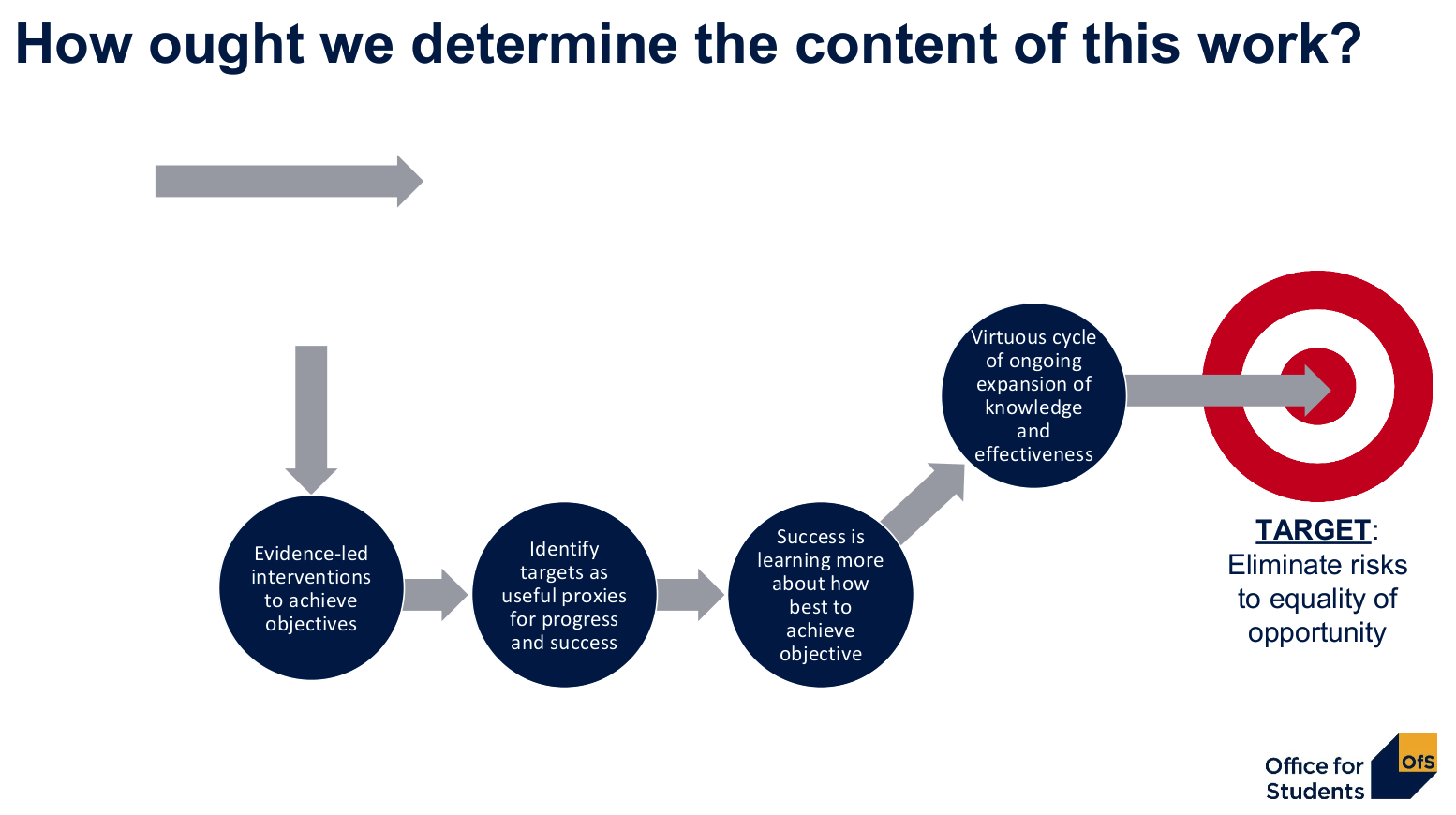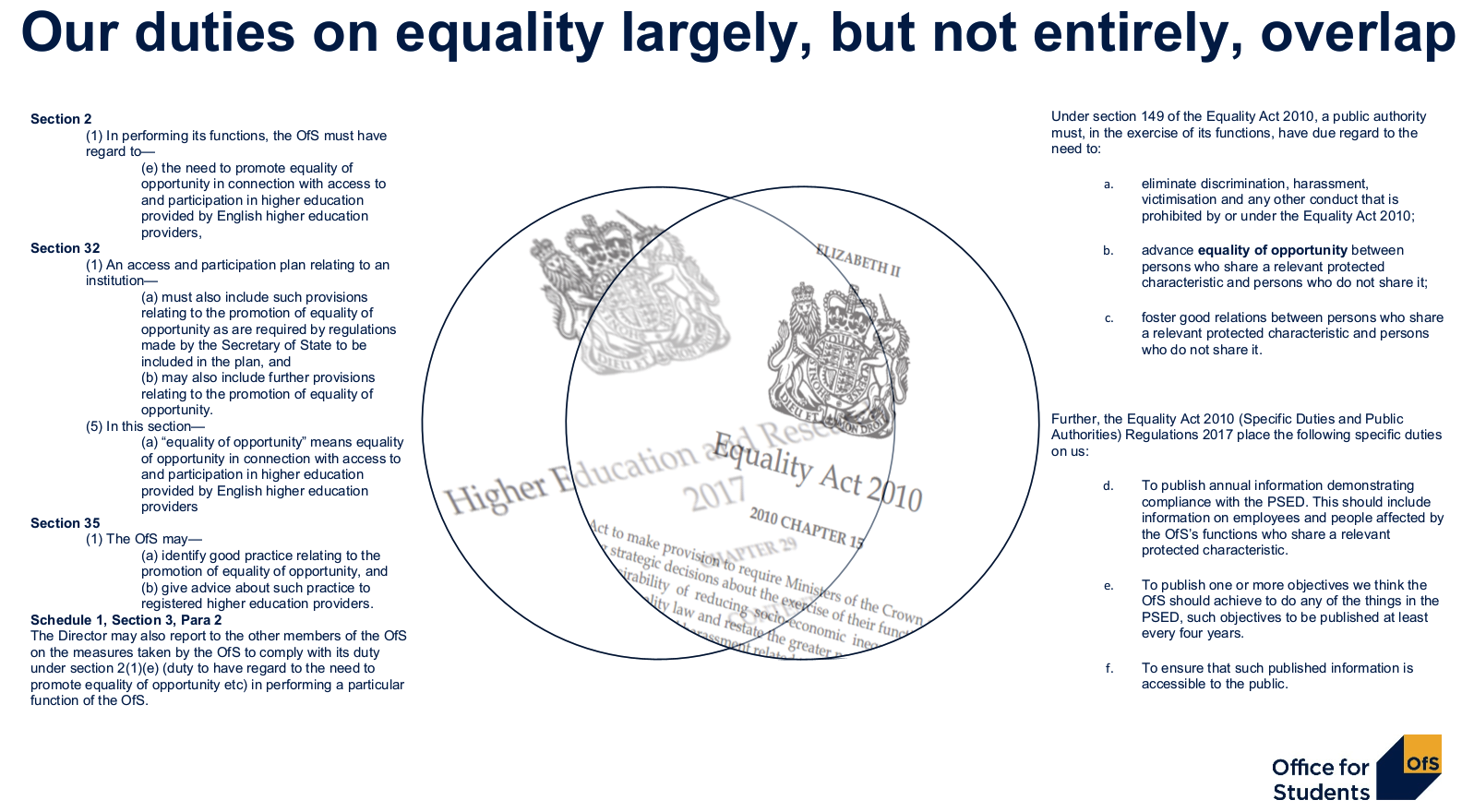Nine months ago, when John Blake was appointed as the Office for Students’ new Director for Fair Access and Participation in the slipstream of new priorities from the ministers that appointed him, a holding position was established on a promise that something more radical would follow.
Access and Participation plan variations were “invited” during the spring to address four new priorities – making them more understandable and accessible to students and key stakeholders, partnering with local schools, getting on as well as getting in, and creating more routes into higher education through the expansion of degree apprenticeships and flexible level four and five qualifications – all overlaid with an “evaluation is crucial” mantra to stop people patting themselves on the back for effort over attainment.
Left hanging was the way in which the schools reformer might reshape the core regulatory system surrounding the equality of opportunity in the Higher Education and Research Act. Would he maintain the metrics-led approach established by former chair Michael Barber? Would the process of getting a plan past the regulator and then being held to it over a longer period survive?
And would we ever see OfS make up its mind about whether to close the gap in participation between the most and least represented groups through expansion (what we might call “levelling up”) or reduction in participation rates in most represented groups (what we might call “going to war with Telegraph readers”)?
Now following a little launch of a consultation, we have some answers to these questions – and depending on your perspective they’re either a clever bit of regulatory design, or an ever-bigger pain in the backside than this agenda has been since it was introduced.
The big ideas? Demonstrating deeper understanding, and risk management.
Creative compliance
Over the months, Blake has evidently clocked that sometimes problems in access and participation work aren’t properly being identified, understood or tackled in their full context.
In other words a university might have identified a gap in the percentage of Asian students getting a graduate job, but not really understood what has been leading to that gap – and perhaps finding ways to hit a numerical target without solving the underlying problem, labelled here as “creative compliance and unintentional negative outcomes”.
Some will regard the subsequent objective of then “harnessing the intellectual and problem-solving knowledge and skill” within the sector to actually identify and understand those problems as a kind of palming off – but universities and their pavlovian desire for autonomy will hardly in a position to object, and anyway, TASO is around to help.
The message here to the sector is – show us you’ve really worked out what’s going on, and even if you work out that 80 percent of the reason that someone doesn’t end up completing the course is outside of your control, both broaden your influence over the 80 percent and do something you can show will work over the 20 percent.
Risky business
Attached to that is, on the surface, a further loosening of the directive approaches that the “fair access” agenda started with – providers are basically being asked to adopt (and adapt) a “risk management” approach over access and participation.
In this context a “risk” to equality of opportunity is specifically not about ensuring equal outcomes for all – but ensuring that differential outcomes are not the result of circumstances individuals cannot fairly influence:
Risks to equality of opportunity occur when an individual, because of circumstances that the individual did not choose, may have their choices about the nature and direction of their life reduced by the actions or inactions of another individual, organisation or system.
There’s a problem here of course – the implication in the above paragraphs is that there are some differences in outcomes that are OK as long as the group chooses them. “Oh, the thing is, the poorer students don’t want to become lawyers” is unlikely to be what Blake really means, and we’re assuming that he understands that the word “choose” has all sorts of complex meanings to unpack.
This does all feel like an attempt at making sense of the Michelle Donelan / Gavin Williamson “we want equality of opportunity rather than equality of outcome” nostrums that both Tony Sewell and Katherine Birbalsingh have been pushing, and may come undone in the face of the intellectual sophistication that Blake is asking gets deployed over fixing the issues.
Risk registration
Nevertheless the compelling ask is less about what’s meant by “risks” to equality of opportunity, and more about the process being expected. The idea is first that OfS will develop a national Equality of Opportunity Risk Register (Chris Millward was Tigger, John Blake is EORR etc) and then providers will have to pay due regard to it when identifying their own risks to equality of opportunity. Determining which are the greatest risks won’t be a matter (only) of quantity of those affected, but also the impact of the quality of life of individuals of a risk manifesting.
That will mean providers establishing a “rational basis” for prioritising activity, and then for the biggest or broadest risks they will then need to develop mitigation steps that prevent or reduce those risks from crystallising. That will form the (“maximum 30 page”) access and participation plan that OfS will either tick out or bounce back, and then monitoring will happen over the life of the four year plan as previously promised.

What OfS wants the sector to remember about all that is that the approach will identify many more risks than it is possible for any one body or even the whole sector to meaningfully manage – and that’s OK; that all risks are not equal and will not require the same level of mitigation; that certain mitigations for risks may not be cost effective in comparison to the scale and severity of the risk; and that mitigation is not abolition.
The message is that OfS accepts that some risks are beyond the power of any part of the sector to erase, and some mitigations may seem worthy but be impractical or inefficient as a result.
So will it work?
First, the risk management confection generates quite an interesting set of issues that may not get highlighted in the consultation. If we glance over at the other area where OfS requires providers to assess and prioritise risks and identify mitigations – student protection plans – we find providers loath to publish those risks in public, and big questions over comparability where some risks are simply missing from some plans and mitigations for those risks vary wildly.
Even if OfS says that that’s a necessary cost of allowing this sort of autonomy, if you really are trying to get poor kids in the door and completing, a big sign above it that says “there’s currently a high risk that if you get in you won’t make it but we’re in the process of mitigating that risk” is unlikely to be the sort of thing the marcomms director is thrilled about.
What’s really going on here is a sort of director’s cut, extended play version of an argument that we’ve heard OfS try to have with the sector before. In one corner is the beleaguered provider that just wants to know what it has to do to get the regulator off its back so it can get on with its day. In the other is OfS trying to stress that if the provider took the underpinning issues seriously, the minimum requirements would meet themselves.
As such, if OfS regulation is regarded as something to protect staff from rather than its concerns built into culture and thinking, it’s bad news – Blake is deprecating the cheat codes.
Subjectivity
Even if you’re trying to take the approach seriously, there will be difficulties. It remains the case that if you really want to get to both getting in and getting on in a large university, and you want to harmonise and integrate that alongside your concern for outcomes, you really need data and planning at subject level.
That “subject” is missing from the announcement altogether is potentially a huge mistake – if providers can’t play the averages on outcomes anymore, why will they be able to still on access? Why will it be right that we can see the percentage of a provider’s law students getting to the second year, and the percentage of Afro-Caribbean students getting to the second year, but not the percentage of Afro-Caribbean law students getting to the second year?
If nothing else, left unaddressed this will continue to mean that access to the professions (and the associated social mobility concerns that highlights) is obscured.
The other thing that I suspect that consultation respondents and Blake will wrestle with is judgements. In the end OfS can will providers to embed the thinking over tactics to get a plan approved all it wants – but it’s going to approve some plans and knock back others. Apparent inconsistency in those judgements will be a source of controversy, and even if two providers both use similar criteria for prioritising risks within an envelope, if they end up with different overall sized A&P risk envelopes in general, trouble is coming.
There’s also the question of Blake’s other equality of opportunity and Equality Act-adjacent duties. Over in the quality bit of OfS there’s an acceptance that “minimum” provision is a qualitative as well as quantitative, outcomes-based judgement – so why not here?
Importantly, Equality Act duties aren’t supposed to be able to be deprioritised – they’re universal and absolute, yet we run the risk here of carefully assessing the risk of a disabled student not getting a graduate job but ignoring the risk of that disabled student not being able to access their lectures for eight weeks.

Blake would do well to require providers to assess the risk that these absolute universal rights aren’t met too – which in turn would allow everything from harassment and sexual misconduct to wider race and racism work to fit the same system of deeper understanding and evidence-led intervention that he’s proposing here.
He’ll also need to explain why students of colour at provider A might have the risk they’ll drop out addressed, while those at provider B have that risk ignored – and if those students have the right to see those prioritisation decisions (that he’ll have signed off on) when applying. In addition if, going into my third UG year, I was told my characteristics’ risks were being dropped as a priority, I might have a lot to say about that.
Getting engaged
There’s also the important question of where student engagement fits. Part of the reason why so many providers are flailing around over cost of living is that their assertions that they will establish deep and productive relationships with groups of students targeted in 2019 APPs have turned out to be chimaeras – so there’s nobody but your common or garden student sabbatical officer to test your cost of living ideas on (if indeed you have any other than “Jim’s article”). Add to that an inflexible reading of “evaluate everything and only do what works”, and you end up where we are.
Noting that both OfS and the sector look wilfully out of touch on cost of living, dealing with issues like that that come up at ministerial whim or as a result of a volatile and uncertain world needs factoring into the design – not least because the latter can impact the extent to which it’s reasonable to hold providers to taking responsibility for a risk. Then, giving SUs the jobs of independently assessing the risks, independently organising the bulk of the engagement as well as reproducing the 2020 duty of independently evaluating progress, will help keep providers honest too.
On that earlier question of where Blake goes with KPM 1, wise old owls will note that the regulatory design here neatly sidesteps the impossible choice I raised at the beginning, and avoids what will look like quotas and target setting for a government that dislikes those approaches instinctively.
The problem is perhaps that it does so by ramping up complexity on the altar of trusting providers to do two things – really embedding access and participation rather than doing it in a team on the edge, and really thinking about why things are being done rather than performing to the test. The scope for both significant success and deep failure feels unusually high – but you can’t argue with the ambition.













